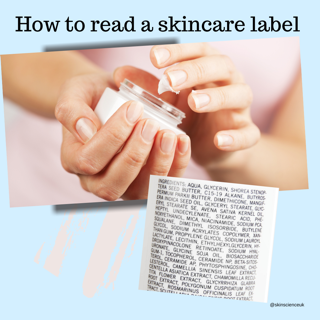How do you know what is in a product?
Its all very well being told what is in a product, but how do you know how much is in it? Is there enough to actually have a clinical effect? or is it just for show?
Skin care labels are notoriously intimidating! its like reading a foreign language! however there are some tips to understanding them...
1. On the label, ingredients will be listed in the order of highest to lowest concentration.
The vehicle is the element present in the highest concentration. It is responsible to carry the other ingredients, creating the actual suspension. So just because water (or aqua) may comprise most of many products, it is usually for good reason.
2. Active ingredients may be listed separately on the label, but this does not mean they are in highest concentration.
Many times the actual active ingredient(s) may be listed by itself. This ingredient is what does the actual work in a product. That does not mean it is the ingredient present in the highest concentration, but rather, the INCI dictates that the company list the active ingredient in this way.
It also means that an ingredient can be promoted as being the active ingredient, but actually not be present in a concentration high enough to actually have an effect!
3. Use common product ingredients as “markers” to estimate the amounts of the other ingredients.
Once you know the ingredients are listed from highest concentration to lowest concentration, there are a few ingredients you can use as “markers” to estimate the concentrations of the rest. For instance:
- If water is the first ingredient on the label, it is likely that 75-95% of the product is comprised of water.
- Fragrance is usually anywhere between .50 and 3% of the product. So any ingredient listed after fragrance is present in a concentration typically less than 3%.
- Vitamin C, unless otherwise listed on the label, is typically less than 1% of the product. Vitamin C creams tend to oxidize when exposed to light, heat, or air, so many companies will try to negate this effect by keeping vitamin C concentrations accordingly low.
- Unless otherwise listed, most products will contain 0.025% or less retinol (our SKIN SCIENCE RETINOL is 1%) The weaker retinyl palmitate may be present in higher concentration.
- Buffers, such as EDTA, are usually present in less than 1% of the product.
4. Any ingredient that is 1% or less of the product can be listed in any order.
Any ingredient present under 1% concentration may be listed in any order as long as it is listed after all of the other ingredients present at or above 1%. This means that a product may contain 0.00001% vitamin C and 1% EDTA, but vitamin C may be listed above EDTA on the label!
Another problem with this is that there is no guideline to disclose where the 1% cut off exists on the label! The best idea is to search for “marker” ingredients like vitamin C or EDTA in order to try to ascertain where the 1% grouping generally occurs on the label, though this method is not fool proof.
There are many other rules to skin care labels, but these are the main ones to remember. It is also worth investigating skin care label 'dictionaries' to look up meanings of some of the names in ingredient lists. This is particularly helpful if you have any allergies, sensitivities are vegetarian or vegan or want to avoid products such as parabens.
As always if you need any help, just get in touch!

